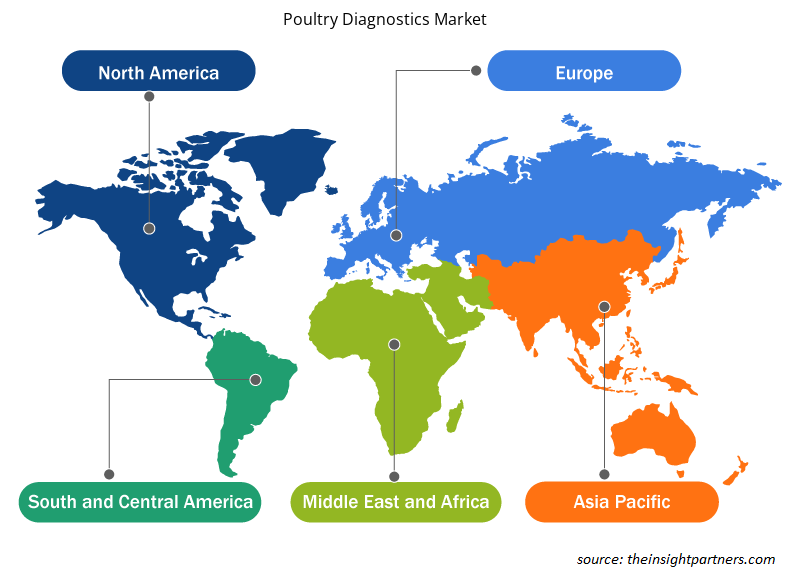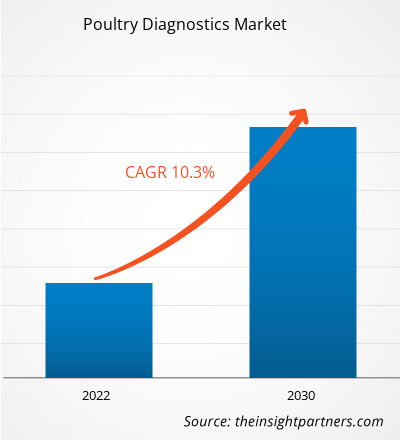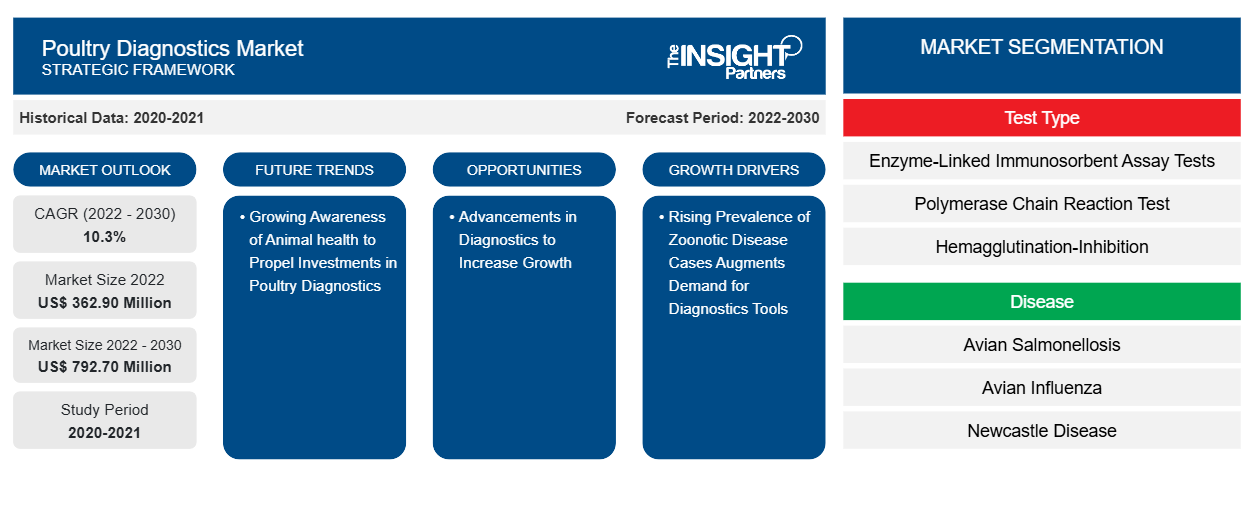Der Markt für Geflügeldiagnostik soll von 362,90 Millionen US-Dollar im Jahr 2022 auf 792,70 Millionen US-Dollar im Jahr 2030 wachsen; der Markt dürfte zwischen 2022 und 2030 eine durchschnittliche jährliche Wachstumsrate (CAGR) von 10,3 % verzeichnen. Die zunehmende Einführung von diagnostischen Plattformen für Geflügel auf landwirtschaftlichen Betrieben wird wahrscheinlich ein wichtiger Trend auf dem Markt bleiben.
Marktanalyse für Geflügeldiagnostik
In der Geflügelmedizin konzentriert sich der Diagnoseprozess nicht mehr nur auf einzelne Tiere, sondern beurteilt den Gesundheitszustand ganzer Herden. Herden gelten als „gesund“, wenn sie ihr genetisches Potenzial ausschöpfen und frei von klinischen Erkrankungen sind. Zu den Diagnoseaktivitäten auf dem Bauernhof gehören routinemäßige Probenentnahmen und Untersuchungen im Rahmen von Gesundheitskontrollprogrammen. National und international eingeführte Kontrollprogramme für bestimmte Mycoplasma- und Salmonellenarten sind wichtige Beispiele. Faktoren wie die zunehmende Verbreitung von Zoonosen und Geflügelkrankheiten steigern die Nachfrage nach Geflügeldiagnostik. Darüber hinaus tragen neue Entwicklungen auf dem Markt zum Marktwachstum im Prognosezeitraum bei.
Marktübersicht für Geflügeldiagnostik
Die Influenza-A-Virussubtypen H9 und H6 haben sich in Haushühnern und Wildgeflügel wie Wachteln und Fasanen etabliert, die in Asien für den Verzehr gezüchtet werden. Im Jahr 2022 meldete China mehrere Vogelgrippevirusstämme, die meist zu den Subtypen H5, H7 oder H9 gehören und häufig Ausbrüche bei Geflügel und/oder Menschen verursachen. Darüber hinaus ist die Marek-Krankheit (MD) in Indien eine der wiederauftretenden Geflügelkrankheiten. Obwohl MD durch Impfungen als gut unter Kontrolle gilt , wurde bei Ausbrüchen eine Herdensterblichkeit von 10–40 % bei geimpften Herden beobachtet. Das Marktwachstum im asiatisch-pazifischen Raum ist auf das Auftreten des Coronavirus des Atemwegssyndroms im Nahen Osten (MERS-CoV) und die Ausbreitung der hochpathogenen Vogelgrippe (H5N1) in vielen asiatischen Ländern zurückzuführen. Die Vogelgrippe verursacht weiterhin erhebliche Verluste bei Geflügel und stellt in vielen Ländern der Region eine zoonotische Bedrohung für die menschliche Bevölkerung dar.
Passen Sie diesen Bericht Ihren Anforderungen an
Sie erhalten kostenlos individuelle Anpassungen an jedem Bericht, einschließlich Teilen dieses Berichts oder einer Analyse auf Länderebene, eines Excel-Datenpakets sowie tolle Angebote und Rabatte für Start-ups und Universitäten.
-
Holen Sie sich die wichtigsten Markttrends aus diesem Bericht.Dieses KOSTENLOSE Beispiel umfasst eine Datenanalyse von Markttrends bis hin zu Schätzungen und Prognosen.
Treiber und Chancen auf dem Geflügeldiagnostikmarkt
Fortschritte in der Geflügeldiagnostik begünstigen den Markt
In den letzten Jahren hat die Erweiterung der diagnostischen Werkzeuge in klinischen mikrobiologischen Laboren die bakteriologischen Untersuchungen in der Geflügelmedizin erheblich beeinflusst. Es gibt einen klaren Trend hin zur Einbeziehung molekularer Techniken und Proteomik, die traditionelle bakteriologische Methoden entweder ergänzen oder ersetzen. Laut einem im September 2022 in Frontiers in Artificial Intelligence veröffentlichten Artikel wurde in Afrika ein Modell mit einem tiefen Convolutional Neural Network (CNN) entwickelt, um Geflügelkrankheiten wie Kokzidiose, Salmonellen und Newcastle durch die Klassifizierung gesunder und ungesunder Stuhlbilder zu diagnostizieren. Die Studie kam zu dem Schluss, dass dieses vorgeschlagene Convolutional Neural Network (CNN)-Modell, das Deep-Learning-Technologie nutzt, voraussichtlich weniger teuer und effektiv bei der Früherkennung sein wird als PCR-Diagnostiktests im Labor. Solche Fortschritte in der Geflügelkrankheitsdiagnostik fördern das Wachstum des Geflügeldiagnosemarktes.
Regierungsinitiativen bieten Wachstumschancen
Die Geflügelzucht ist eine wichtige Einnahmequelle für Landwirte in Entwicklungsländern. Die Geflügelindustrie steht vor Herausforderungen in Bezug auf Immunität, Gesundheit und Produktion, darunter die Aufrechterhaltung des Verbrauchervertrauens, Produktqualität und -sicherheit sowie Krankheitsmanagement . Durch Lebensmittel übertragene und zoonotische Krankheiten sind eng mit Geflügel verbunden und stellen erhebliche Herausforderungen dar. Die Kontrolle und Beseitigung dieser Krankheitserreger ist eine große Herausforderung für die Industrie. Darüber hinaus ist die Berücksichtigung der gesundheitlichen Bedenken der Öffentlichkeit im Zusammenhang mit dem Verzehr von Lebensmitteln mit hohen Antibiotikarückständen ein kritisches Thema. Um diese Herausforderungen zu bewältigen, sind eine sektorübergreifende Zusammenarbeit und staatliche Maßnahmen, die Geflügelhalter in Kleinbetrieben erreichen, von entscheidender Bedeutung. Eine erfolgreiche Kontrolle würde den Lebensunterhalt, die Ernährung und die Geschlechtergerechtigkeit von Millionen ländlicher Familien verbessern. Laut einem 2024 vom Veterinary & Animal Husbandry Services (V&AHS) veröffentlichten Artikel zielt das Programm Nr. 1 darauf ab, die notwendigen tiermedizinischen Einrichtungen und klinischen Hilfsmittel für Nutztiere bereitzustellen, um Tierkrankheiten durch richtige Diagnose, Massenimmunisierung und Bereitstellung einer rationalen Behandlung zu kontrollieren und einzudämmen. Solche staatlichen Programme und Initiativen zur Unterstützung der Diagnostik in der Geflügelzucht würden Geflügelproduzenten im Vergleich zu einer einfachen Diagnose zahlreiche Marktchancen bieten.
Segmentierungsanalyse des Marktberichts zur Geflügeldiagnostik
Wichtige Segmente, die zur Ableitung der Marktanalyse für Geflügeldiagnostik beigetragen haben , sind Testtyp und Krankheit.
- Der Markt für Geflügeldiagnostik ist nach Testtyp in Enzymimmunoassays (ELISA), Polymerase-Kettenreaktion (PCR), Hämagglutinationshemmung (HI) und andere unterteilt. Das Segment ELISA-Tests hatte 2023 den größten Marktanteil.
- Nach Krankheit ist der Markt in Vogelsalmonellose, Vogelgrippe, Newcastle-Krankheit, Vogelmykoplasmose, infektiöse Bronchitis und andere unterteilt. Das Segment Vogelgrippe hatte im Jahr 2022 den größten Marktanteil.
Marktanteilsanalyse für Geflügeldiagnostik nach geografischer Lage
Der geografische Umfang des Marktberichts zur Geflügeldiagnostik ist hauptsächlich in fünf Regionen unterteilt: Nordamerika, Asien-Pazifik, Europa, Naher Osten und Afrika sowie Süd- und Mittelamerika.
Nordamerika hält den größten Marktanteil am Markt für Next-Generation-Sequencing. Der Markt für Geflügeldiagnostik in Nordamerika wird anhand der USA, Kanadas und Mexikos analysiert. Schätzungen zufolge werden die USA den nordamerikanischen Markt für Geflügeldiagnostik im Jahr 2023 dominieren. Laut den von der Ernährungs- und Landwirtschaftsorganisation der Vereinten Nationen (UNFAO) veröffentlichten Statistiken gab es im Jahr 2022 einen Anstieg der Eier- und Hühnerproduktion in Nordamerika. Die Regierung erwägt eine Massenimpfkampagne für Geflügel. Am 5. Juli 2022 gab das US-Landwirtschaftsministerium (USDA) an, dass in 36 US-Bundesstaaten 40,09 Millionen Vögel mit der hochpathogenen Vogelgrippe (HPAI) infiziert sind.
Das Marktwachstum in Nordamerika ist auf die zunehmende Zahl von Geflügelkrankheiten und die steigende Nachfrage nach Geflügelprodukten in der Region zurückzuführen.
Regionale Einblicke in den Markt für Geflügeldiagnostik
Die regionalen Trends und Faktoren, die den Markt für Geflügeldiagnostik im Prognosezeitraum beeinflussen, wurden von den Analysten von Insight Partners ausführlich erläutert. In diesem Abschnitt werden auch die Marktsegmente und die Geografie für Geflügeldiagnostik in Nordamerika, Europa, im asiatisch-pazifischen Raum, im Nahen Osten und Afrika sowie in Süd- und Mittelamerika erörtert.

- Erhalten Sie regionale Daten zum Markt für Geflügeldiagnostik
Umfang des Marktberichts zur Geflügeldiagnostik
| Berichtsattribut | Details |
|---|---|
| Marktgröße im Jahr 2022 | 362,90 Millionen US-Dollar |
| Marktgröße bis 2030 | 792,70 Millionen US-Dollar |
| Globale CAGR (2022 - 2030) | 10,3 % |
| Historische Daten | 2020-2021 |
| Prognosezeitraum | 2022–2030 |
| Abgedeckte Segmente |
Nach Testtyp
|
| Abgedeckte Regionen und Länder |
Nordamerika
|
| Marktführer und wichtige Unternehmensprofile |
|
Marktteilnehmerdichte im Bereich Geflügeldiagnostik: Auswirkungen auf die Geschäftsdynamik verstehen
Der Markt für Geflügeldiagnostik wächst rasant, angetrieben durch die steigende Nachfrage der Endnutzer aufgrund von Faktoren wie sich entwickelnden Verbraucherpräferenzen, technologischen Fortschritten und einem größeren Bewusstsein für die Vorteile des Produkts. Mit steigender Nachfrage erweitern Unternehmen ihr Angebot, entwickeln Innovationen, um die Bedürfnisse der Verbraucher zu erfüllen, und nutzen neue Trends, was das Marktwachstum weiter ankurbelt.
Die Marktteilnehmerdichte bezieht sich auf die Verteilung der Firmen oder Unternehmen, die in einem bestimmten Markt oder einer bestimmten Branche tätig sind. Sie gibt an, wie viele Wettbewerber (Marktteilnehmer) in einem bestimmten Marktraum im Verhältnis zu seiner Größe oder seinem gesamten Marktwert präsent sind.
Die wichtigsten auf dem Markt für Geflügeldiagnostik tätigen Unternehmen sind:
- Thermo Fisher Scientific Inc
- Idexx Laboratories Inc
- Qiagen NV
- Eurofins Scientific SE
- IDVET
- Boehringer Ingelheim International GmbH
Haftungsausschluss : Die oben aufgeführten Unternehmen sind nicht in einer bestimmten Reihenfolge aufgeführt.

- Überblick über die wichtigsten Akteure auf dem Markt für Geflügeldiagnostik
Neuigkeiten und aktuelle Entwicklungen zum Markt für Geflügeldiagnostik
Der Markt für Geflügeldiagnostik wird durch die Erhebung qualitativer und quantitativer Daten aus Primär- und Sekundärforschung bewertet, die wichtige Unternehmenspublikationen, Verbandsdaten und Datenbanken umfasst. Nachfolgend sind einige der Entwicklungen auf dem Markt für Geflügeldiagnostik aufgeführt:
- IDEXX Laboratories, Inc. USA ist eine Partnerschaft mit Haychem Bangladesh Limited (einer Tochtergesellschaft von Hayleys Agriculture Holdings Limited, Sri Lanka) eingegangen. Ziel der Partnerschaft ist es, das Produktangebot von IDEXX in Bangladesch zu erweitern und das Angebot an Veterinärimpfungen und -diagnostik zu erhöhen. (Quelle: Hayleys Agriculture Holdings Limited, Pressemitteilung, 2023)
- Qiagen NV gab die US-FDA-Zulassung für das „therascreen PDGFRA RGQ PCR-Kit“ (therascreen PDGFRA-Kit) bekannt. Das neue Produkt soll Kliniker bei der Identifizierung von Patienten mit gastrointestinalen Stromatumoren (GIST) zur Behandlung von „AYVAKIT (Avapritinib)“ unterstützen (Quelle: QIAGEN, Pressemitteilung, 2023)
Marktbericht zur Geflügeldiagnostik – Umfang und Ergebnisse
Der Bericht „Marktgröße und Prognose für Geflügeldiagnostik (2020–2030)“ bietet eine detaillierte Analyse des Marktes, die die folgenden Bereiche abdeckt:
- Marktgröße und Prognose für Geflügeldiagnostik auf globaler, regionaler und Länderebene für alle wichtigen Marktsegmente, die im Rahmen des Berichts abgedeckt sind
- Markttrends für Geflügeldiagnostik sowie Marktdynamik wie Treiber, Einschränkungen und wichtige Chancen
- Detaillierte PEST/Porters Five Forces- und SWOT-Analyse
- Marktanalyse für Geflügeldiagnostik mit Blick auf wichtige Markttrends, globale und regionale Rahmenbedingungen, wichtige Akteure, Vorschriften und aktuelle Marktentwicklungen
- Branchenlandschaft und Wettbewerbsanalyse, die die Marktkonzentration, Heatmap-Analyse, prominente Akteure und aktuelle Entwicklungen auf dem Markt für Geflügeldiagnostik umfasst
- Detaillierte Firmenprofile
- Historische Analyse (2 Jahre), Basisjahr, Prognose (7 Jahre) mit CAGR
- PEST- und SWOT-Analyse
- Marktgröße Wert/Volumen – Global, Regional, Land
- Branchen- und Wettbewerbslandschaft
- Excel-Datensatz
Aktuelle Berichte
Erfahrungsberichte
Grund zum Kauf
- Fundierte Entscheidungsfindung
- Marktdynamik verstehen
- Wettbewerbsanalyse
- Kundeneinblicke
- Marktprognosen
- Risikominimierung
- Strategische Planung
- Investitionsbegründung
- Identifizierung neuer Märkte
- Verbesserung von Marketingstrategien
- Steigerung der Betriebseffizienz
- Anpassung an regulatorische Trends























 Kostenlose Probe anfordern für - Markt für Geflügeldiagnostik
Kostenlose Probe anfordern für - Markt für Geflügeldiagnostik